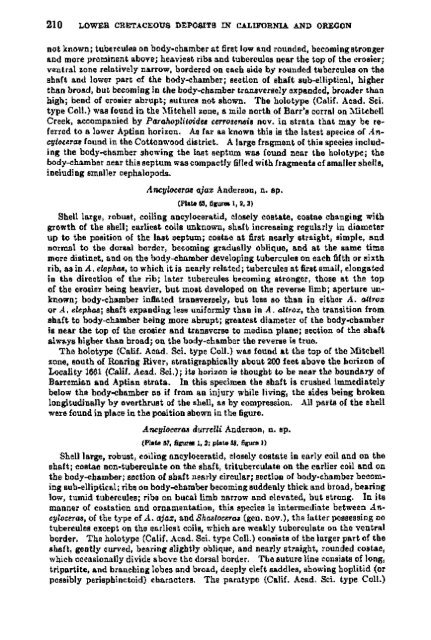LOWER CRETACEOUS DEPOSITS CALIFORNIA AND OREGON
LOWER CRETACEOUS DEPOSITS CALIFORNIA AND OREGON
LOWER CRETACEOUS DEPOSITS CALIFORNIA AND OREGON
You also want an ePaper? Increase the reach of your titles
YUMPU automatically turns print PDFs into web optimized ePapers that Google loves.
210 <strong>LOWER</strong> CRETACEOtffi <strong>DEPOSITS</strong> IN <strong>CALIFORNIA</strong> <strong>AND</strong> <strong>OREGON</strong><br />
not known; tuhereules on body-chamber at first low and rounded, becoming stronger<br />
and more prominent above; heaviest ribs and tubercules near the top of the crosier;<br />
ventral lone relatively narrow, bordered on each side by rounded tubercules on tho<br />
shaft and lower part of the body-chamber; section of shaft sub-elliptical, higher<br />
than broad, but becoming in the body-chamber transversely expanded, broader than<br />
high; bend of crosier abrupt; sutures not shown. The holotype (Calif. Acad. Sci,<br />
type Coll.) was found in the Mitchell zone, a mile north of Barr's corral on Mitchell<br />
Creek, accompanied by ParaAoph'bndes cerroiemii nov. in strata that may be referred<br />
to a lower Aptian horizon. As far aa known thiB is the latest species of Aneyiecna*<br />
found in the Cottonwood district. A large fragment of thia apecies including<br />
the body-chamber showing the last septum was found near the holotype; the<br />
body-chamber near tlila septum was compactly filled with fragments of smaller sheila,<br />
including smaller cephalopoda.<br />
Ancyloceras ajax Anderson, n. sp.<br />
(Plata is, fiiu i, 2. a)<br />
Shell large, robust, coiling ancyloceratid, closely costate, costae changing with<br />
growth of the shell; earliest coils unknown, shaft increasing regularly in diameter<br />
up to the position of the last septum; coatae at first nearly straight, simple, and<br />
normal to the dorsal border, becoming gradually oblique, and at the same time<br />
more distinct, and on the body-chamber developing tubercules on each fifth or sixth<br />
rib, ss in A, eiephas, to which it is nearly related; tubercuka at first email, elongated<br />
in tha direction of the rib; later tubercules becoming stronger, those at the top<br />
of the crosier being heavier, but most developed on the reverse limb; aperture unknown;<br />
body-chamber inflated transversely, but less so than in either A. aitrox<br />
or A, eiipAoa; shaft expanding less uniformly than in A. oliroi, the transition from<br />
shaft to body-chamber being more abrupt; greatest diameter of the body-chamber<br />
ia near the top of the crosier and transverse to median plane; section of the shaft<br />
always higher than broad; on the body-chamber the reverse ia true.<br />
Tha holotype (Calif. Acad. Sci. type Coll.) was found at the top of the Mitchell<br />
sane, south of Rearing River, atratigraphically about 200 feet above the horizon of<br />
Locality 1601 (Calif. Acad. Sci.); its horizon is thought to be near the boundary of<br />
Barremian and Aptian strata. In this specimen the shaft is crushed Immediately<br />
below the body-chamber as if from an injury while living, the sides being broken<br />
longitudinally by over-thrust of the shell, aa by compression. All parts of the shell<br />
were found in place in the position shown in the figure.<br />
Ancylaecraa durrdli Anderson, n. ap.<br />
(Plato ft?, &eutm 1, S; plate 00. Sgura 1)<br />
Shell large, robust, coiling ancyloceratid, closely costate in early coil and on the<br />
shaft; costae non-tuberculate on the shaft, trituberculate on the earlier coil and on<br />
tbe body-chamber; section of shaft nearly circular; section of body-chamber becoming<br />
sub-elliptical; ribs on body-chamber becoming suddenly thick and broad, bearing<br />
low, tumid tubercules; ribs on bue&l limb narrow and elevated, but strong. In its<br />
manner of eoatation and ornamentation,, this spccies is intermediate between A«eyhcetae,<br />
of the type of A. aj.ax, and SAasfcceroj (gen. nov.), tha latter possessing no<br />
tuberculsa except on the earliest coils, which are weakly tuberculate on the ventral<br />
border. The holotype (Calif. Acad, Sci. type Coll.) consists of the larger p&rt of the<br />
shaft, gently curved, bearing slightly oblique, and nearly straight, rounded costae,<br />
which occasionally divide above the dorsal border. The suture line consists of long,<br />
tripartite, and branching lobes and broad, deeply cleft saddles, showing hopiitid (or<br />
possibly perisphinctoid) charaetera. The pamtype (Calif. Acad- Sei. type Coll.)

















